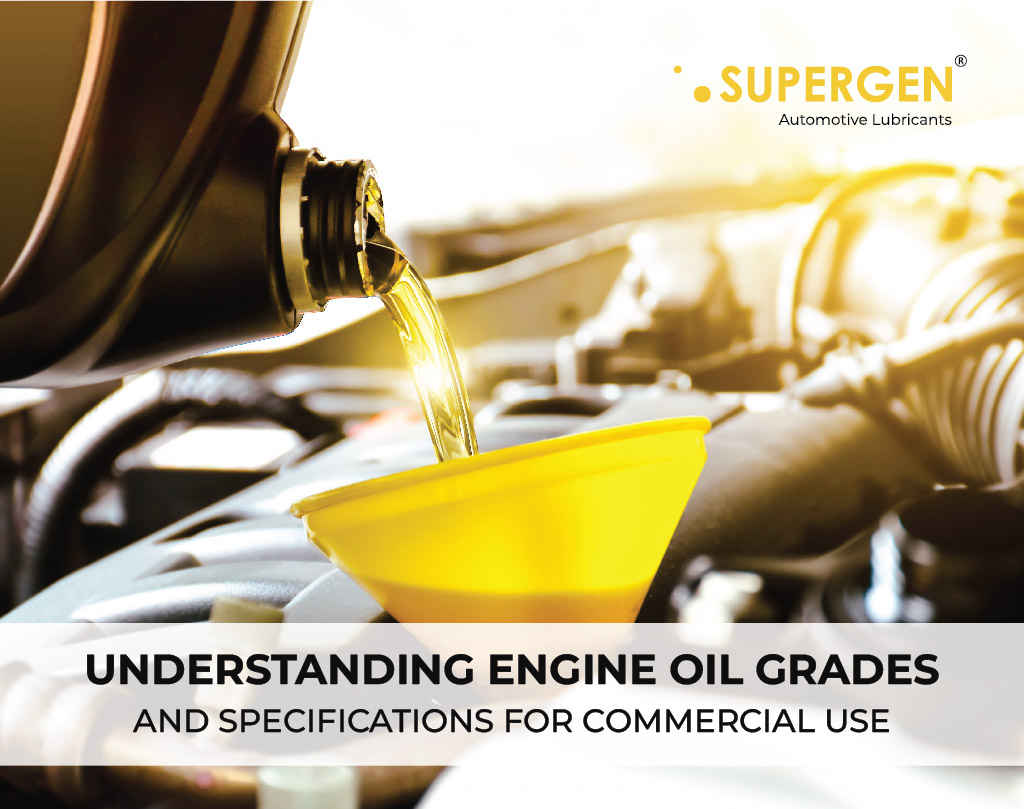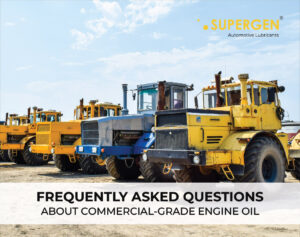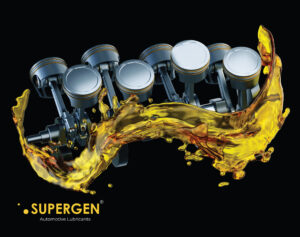Engine oil is the lifeblood of any commercial vehicle or industrial machinery, ensuring optimal performance, efficiency, and longevity. However, selecting the right engine oil is not as simple as picking any available product.
Understanding engine oil grades and specifications is crucial for fleet managers, mechanics, and business owners who rely on commercial vehicles for daily operations.
This comprehensive guide delves into the world of engine oil grades, viscosity classifications, performance standards, and key factors to consider when choosing the right lubricant for commercial use.
What Are Engine Oil Grades?
Engine oil grades refer to the viscosity and performance characteristics of lubricants, classified by regulatory bodies such as the Society of Automotive Engineers (SAE). Viscosity is a measure of an oil’s resistance to flow, which directly affects engine performance and efficiency.
Understanding SAE Viscosity Ratings
The SAE classification system assigns a numerical grade to engine oils, which can be a single-grade (e.g., SAE 30) or multi-grade (e.g., 10W-40). The ‘W’ in multi-grade oils stands for ‘Winter,’ indicating how well the oil flows in cold temperatures.
- Single-grade oils (SAE 30, SAE 40, etc.) are typically used in older engines or warm climates.
- Multi-grade oils (10W-30, 15W-40, etc.) offer better adaptability to varying temperatures, making them ideal for commercial vehicles operating in diverse conditions.
For example, a 10W-40 oil means:
- 10W – The oil maintains sufficient viscosity at low temperatures, ensuring smooth cold starts.
- 40 – The oil retains its thickness at high engine operating temperatures, providing adequate lubrication.
Engine Oil Specifications for Commercial Use
Commercial engines, including those in trucks, buses, construction equipment, and agricultural machinery, require oils that meet stringent industry standards. Various organizations regulate engine oil specifications to ensure performance, longevity, and environmental compliance.
Key Engine Oil Standards
1. API (American Petroleum Institute) Standards
The API classification system indicates whether an oil meets specific industry performance levels. The two main API categories are:
- S-series (Service Category): For gasoline engines (e.g., API SN, API SP).
- C-series (Commercial Category): For diesel engines (e.g., API CK-4, API FA-4).
For heavy-duty diesel engines, API CK-4 is a commonly recommended oil, offering improved oxidation stability, aeration control, and wear protection compared to its predecessors.
2. ACEA (European Automobile Manufacturers’ Association) Standards
ACEA classifications are widely used in Europe and include categories such as:
- E4, E6, E7, E9 – Designed for commercial diesel engines with varying emission control requirements.
For example, ACEA E9 is ideal for modern commercial diesel engines with advanced emission controls and extended drain intervals.
3. OEM (Original Equipment Manufacturer) Approvals
Manufacturers of trucks and heavy equipment establish their own oil requirements to ensure compatibility with specific engine designs. Always check for OEM approvals when selecting oil for commercial vehicles.
Factors to Consider When Choosing Engine Oil for Commercial Use
1. Operating Temperature and Climate
Engines operating in extreme temperatures require oils with suitable viscosity ratings. For cold climates, lower winter viscosity oils (e.g., 5W-40) improve startup protection. In hotter regions, higher viscosity oils (e.g., 15W-40) prevent excessive thinning.
2. Engine Type and Fuel Used
Different engines require different oil formulations. Diesel engines, for instance, demand oils with better soot and deposit control, while natural gas engines require oils with specific additive compositions to counteract combustion by-products.
3. Drain Intervals and Maintenance Schedules
Some commercial oils are formulated for extended drain intervals, reducing downtime and maintenance costs. Always follow manufacturer recommendations to ensure optimal engine performance.
4. Additive Packages and Detergent Levels
High-quality engine oils contain additives that enhance performance, including:
- Detergents – Prevent sludge and carbon deposits.
- Dispersants – Keep contaminants in suspension to avoid clogging.
- Anti-wear agents – Protect metal components from friction.
- Oxidation inhibitors – Extend oil life by preventing degradation.
- Viscosity Index Improvers – Maintain stability across a range of temperatures.
- Corrosion Inhibitors – Prevent rust and metal degradation within the engine.
5. Fuel Economy and Emission Compliance
Some modern engine oils are designed to enhance fuel economy by reducing friction within the engine. Additionally, low-ash formulations help reduce emissions, making them a suitable choice for meeting stringent environmental regulations.
Common Myths and Misconceptions About Engine Oils
Myth 1: “Thicker Oil Always Provides Better Protection”
While high-viscosity oils provide better high-temperature protection, they can reduce fuel efficiency and hinder cold starts. It’s essential to use the manufacturer-recommended viscosity grade.
Myth 2: “All Engine Oils Are the Same”
Different oils contain unique additive packages, base oil compositions, and performance characteristics. Choosing the wrong oil can lead to poor lubrication, sludge buildup, and engine wear.
Myth 3: “You Don’t Need to Change Oil If It Looks Clean”
Oil degrades over time, losing its protective properties even if it appears clean. Regular oil changes are crucial for maintaining engine health.
Myth 4: “Synthetic Oils Damage Older Engines”
Modern synthetic oils are formulated to be compatible with both new and older engines, providing superior protection and longevity compared to conventional oils.
Let’s Conclude
Understanding engine oil grades and specifications is vital for ensuring the longevity and efficiency of commercial engines.
Whether managing a fleet of trucks, operating heavy machinery, or maintaining agricultural equipment, selecting the right engine oil can significantly impact performance, fuel economy, and maintenance costs.
By considering SAE viscosity grades, API/ACEA classifications, OEM approvals, and operating conditions, businesses can make informed decisions and optimize engine reliability. Always refer to the manufacturer’s guidelines and consult with lubrication experts when necessary.
Choosing the right engine oil isn’t just about protecting the engine—it’s an investment in the smooth operation and profitability of your commercial ventures.
FAQ’s
1. How often should commercial engine oil be changed?
Oil change intervals depend on the type of engine, operating conditions, and the oil used. Always follow the manufacturer’s recommendations, but heavy-duty vehicles may require changes between 10,000 to 50,000 miles depending on usage.
2. Can I mix different viscosity grades of engine oil?
It is generally not recommended to mix different viscosity grades, as this can alter the oil’s performance characteristics and reduce its effectiveness.
3. What happens if I use the wrong engine oil?
Using the wrong engine oil can lead to poor lubrication, increased engine wear, reduced fuel efficiency, and even engine damage over time.
4. Are synthetic oils better than conventional oils?
Synthetic oils offer superior performance in extreme temperatures, better wear protection, and longer drain intervals. However, the best choice depends on your engine’s specific requirements.
5. How can I determine if an oil meets my engine’s requirements?
Check the oil’s API, ACEA, or OEM specifications to ensure compatibility with your engine. Always refer to the vehicle or equipment manufacturer’s recommendations.








